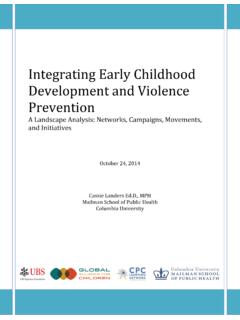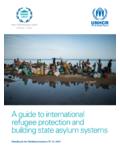Transcription of INTER AGENCY GUIDELINES FOR CASE MANAGEMENT & …
1 INTER AGENCY GUIDELINES FOR case MANAGEMENT & CHILD PROTECTIONTHE ROLE OF case MANAGEMENT IN THE PROTECTION OF CHILDREN: A GUIDE FOR POLICY & PROGRAMME MANAGERS AND CASEWORKERS JANUARY 2014 Front page image: Tdh/M lanie RouillerChild protection working group INTER AGENCY guidelines3 Acknowledgements ..4 GLOSSARY & WORKING DEFINITIONS ..5 Acronyms and Abbreviations ..7 INTRODUCTION TO THE GUIDELINES ..8 Background to the Development of the GUIDELINES ..8 Format of the GUIDELINES ..9 SECTION 1 Principles & Practices ..10 What is case MANAGEMENT ? ..10 Guiding Principles for case MANAGEMENT ..13 SECTION 2 Establishing and Strengthening case MANAGEMENT Services ..20 Contexts for Developing / Introducing case MANAGEMENT ..20 Analysing External and Internal Capacities and Constraints ..24 Analyse Internal AGENCY Capacity ..28 Complementary Activities as Alternatives to Establishing case MANAGEMENT ..32 Essential Elements of Designing & Implementing a case MANAGEMENT Services.
2 34 SECTION 3 - case MANAGEMENT Steps ..44 STEP 1 - Identification and Registration ..46 STEP 2 - STEP 3 - case Planning ..54 STEP 4 - Implementing the case Plan ..55 STEP 5 - Follow Up and Review ..58 STEP 6 - case Closure ..61 case STUDIES ..63 Appendices for Reference: ..66 APPENDIX 1: Caseworker competency and skill framework ..67 APPENDIX 2: Roles of Supervisors vs. Caseworkers ..70 APPENDIX 3: Sample of child protection/ child safeguarding policy ..72 APPENDIX 4: Samples of registration forms ..78 APPENDIX 5: Samples of assessment forms ..87 APPENDIX 6: Risk assessment guide ..93 APPENDIX 7: Sample of case planning form ..97 APPENDIX 8: Sample of follow up form ..98 APPENDIX 9: Sample of case conference report ..99 APPENDIX 10: case closure form ..101 APPENDIX 11: case transfer Form ..102 APPENDIX 12: Sample of data protection protocol ..103 APPENDIX 13: Sample of informed consent ..108 CONTENTSC hild protection working group INTER AGENCY guidelines4 Anyone who has ever done case MANAGEMENT knows what a complicated and often difficult task it is.
3 In regular situations this is already the case . In emergency situations - where levels of injury, physical violence, sexual violence, psychosocial distress, association with armed groups and separation are amplified - interventions are even more complex. The number of child protection cases is high , problems are multifaceted, social welfare staff is often overstretched and resources are more limited. We know that a time-limited, hourly session with a child will not guarantee his/her protection. Careful assessment and support of (and for) family members and caregivers as well as liaison with community members, school personnel, court-related personnel, and child welfare agencies increases the likelihood that the child will remain safe and promote healthy relationships with others. These GUIDELINES have been developed at an INTER - AGENCY level to complement the agreed standard on case MANAGEMENT (Minimum Standards for Child Protection in Humanitarian Action, 2012). They aim to provide a common understanding and step-by-step guidance on how to do case MANAGEMENT .
4 They put the child at the centre of the intervention, focusing on child friendly procedures and language. I urge agencies working in the field of Child Protection in emergencies to use and adhere to these GUIDELINES in order to jointly provide the best possible support to the children that we serve. Katy Barnett, Coordinator Global Child Protection Working GroupFOREWORDC hild protection working group INTER AGENCY guidelines5 Numerous organisations and individuals were involved in developing these GUIDELINES ; the Child Protection Working Group would like to express their thanks to everyone who has contributed information and ideas. In particular thanks are due to the members of the Child Protection Working Group (CPWG) s case MANAGEMENT Taskforce (The International Rescue Committee, Save the Children, Child Frontiers, Terre des Hommes, UNICEF, Plan International, International Medical Corps and independent consultants).Special thanks also go to the European Community Humanitarian Office (ECHO) and the Office for US Foreign Disaster Assistance (OFDA) of the united States AGENCY for International Development for making the development of these GUIDELINES possible.
5 ACKNOWLEDGEMENTSC hild protection working group INTER AGENCY guidelines6 Alternative Care: Alternative care is the care provided for children by caregivers who are not their biological parents. This care may take the form of informal or formal care. Alternative care may be kinship care; foster care; other forms of family-based or family-like care placements; residential care; supervised independent living arrangements for MANAGEMENT : The process of helping individual children and families through direct social-work type support, and information : The key worker in a case who maintains responsibility for the child s care from identification to case closureChild Protection: The prevention of and response to abuse, neglect, exploitation, and violence against childrenChild Protection System: The set of laws, policies, regulations and services needed across all social sectors especially social welfare, education, health, security and justice to support prevention and protective responses inclusive of family strengthening.
6 2 Non-discrimination: The principle that distinctions should not be made between people or communities on any grounds of status, including age, gender, race, colour, ethnicity, national or social origin, sexual orientation, HIV status, language, religion, disability, health status, political or other factors: Conditions or attributes in individuals, families, communities, or the larger society that, when present, mitigate or eliminate risk in families and communities that, when present, increase the health and well-being of children and Alternative Care in Emergency toolkit. Extended care guidance. INTER AGENCY Working Group on Unaccompanied and Separated Children2. UNICEF Global Strategy, 2008. 3. Preventing Child Maltreatment and Promoting Well-Being: A Network for Action, Resource Guide. 2013 GLOSSARY & WORKING DEFINITIONSC hild protection working group INTER AGENCY guidelines7 Psychosocial Support: Care and support which influences both the individual and the social environment in which people live and ranges from care and support offered by caregivers, family members, friends, neighbours, teachers, health workers, and community members on a daily basis but also extends to care and support offered by : The process of formally requesting services for a child or their family from another AGENCY ( cash assistance, health care, etc.)
7 Through an established procedure and/or form; caseworkers maintain overall responsibility for the case regardless of : The ability of children and their families to deal with, and recover from, adversity and crisis, influenced by individual characteristics and external factors like: diversity of livelihoods, coping mechanisms, life skills such as problem-solving, the ability to seek support, motivation, optimism, faith, perseverance and resourcefulness. Risk: The likelihood that a hazard will happen, its magnitude and its consequences; the probability of external and internal threats ( armed attacks, natural disasters, gender-based violence) occurring in combination with individual vulnerabilities ( poverty, disability, membership of a marginalized group)5 Risk Assessment: Methodology to determine the nature and extent of risk by taking into account potential hazards and existing conditions of vulnerability that together could harm children and their families.
8 Risk assessments should take into account community capacity to resist or recover from the hazard s Vulnerability: Physical, social, economic and environmental factors that increase the susceptibility of a community or individuals to difficulties and hazards and that put them at risk as a result of loss, damage, insecurity, suffering and deathOrganisations / AGENCY used interchangeablyIn different settings people may use different terms such as client or case to refer to the individual at the centre of a case plan. As this guidance relates specifically to the MANAGEMENT of child protection concerns, the term child is generally used. 4. Action for the Right of the child. ARC resource pack. 2009 5. Minimum Standards for Child Protection in Humanitarian Action, Child Protection Working Group, 2012 6. protection working group INTER AGENCY guidelinesACRONYMS AND ABBREVIATIONSCM: case ManagementCP: Child protectionCPMS: Child Protection Minimum StandardsCPWG: Child Protection Working GroupECHO: European Community Humanitarian Aid OfficeHIV: Human Immunodeficiency VirusIA CP IMS: INTER AGENCY Child Protection Information MANAGEMENT SystemIRC: International Rescue CommitteeMDG: Multidisciplinary Group MeetingNGO: Non-Governmental OrganizationOFDA: Office of the US Foreign Disaster AssistanceTdh: Terre des HommesUASC: Unaccompanied and Separated ChildrenUNCRC: united nations Convention of the Rights of the ChildUNHCR: united nations Commissioner for RefugeesUNICEF.
9 united nations Children s Fund8 Child protection working group INTER AGENCY guidelines9 BACKGROUND TO THE DEVELOPMENT OF THE GUIDELINESThe GUIDELINES were developed in recognition of the increased emphasis and interest being placed upon case MANAGEMENT as a service part of a child protection system. case MANAGEMENT is not new; however its application in humanitarian settings is relatively intention in developing these GUIDELINES was to provide a general framework of agreed principles, considerations, steps and procedures for effective child protection case MANAGEMENT in line with the Minimum Standards for Child Protection in Humanitarian Action (CPMS)7 developed in 2012 by the Child Protection Working Group (CPWG). This is to provide interventions in line with Standard 15 of CPMS, which states:Girls and boys with urgent child protection needs are identified and receive age- and culturally-appropriate information as well as an effective, multi-sectorial and child-friendly response from relevant providers working in a coordinated and accountable manner.
10 The primary focus of these GUIDELINES is for use by agencies and practitioners in humanitarian settings. However, these GUIDELINES can also be a useful resource for governments and agencies working in more stable or development situations. Likewise, these GUIDELINES can be helpful additional guidance in refugee situations, but practices would need to take into account broader refugee case MANAGEMENT including the specific Best Interest we have tried to make these GUIDELINES as user-friendly and simple as possible, we have assumed that agencies and staff engaging in case MANAGEMENT work have some training and experience in providing care and support to children with child protection materials on case MANAGEMENT have being developed by the CPWG to accompany these GUIDELINES . In addition, there are a number of other training packages and useful resources, which are included in the Resources Section at the end of the note that these GUIDELINES are about case MANAGEMENT , not child protection programming generally.







